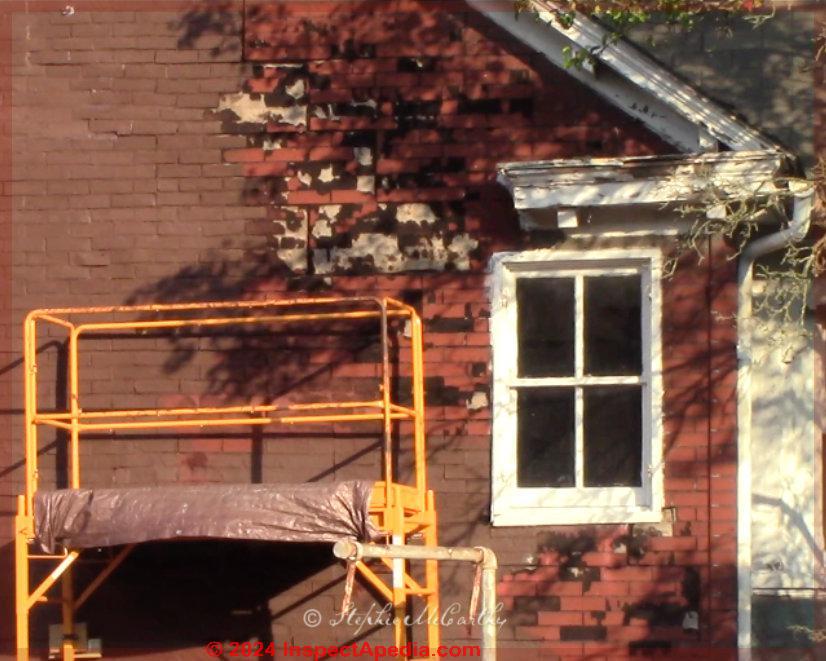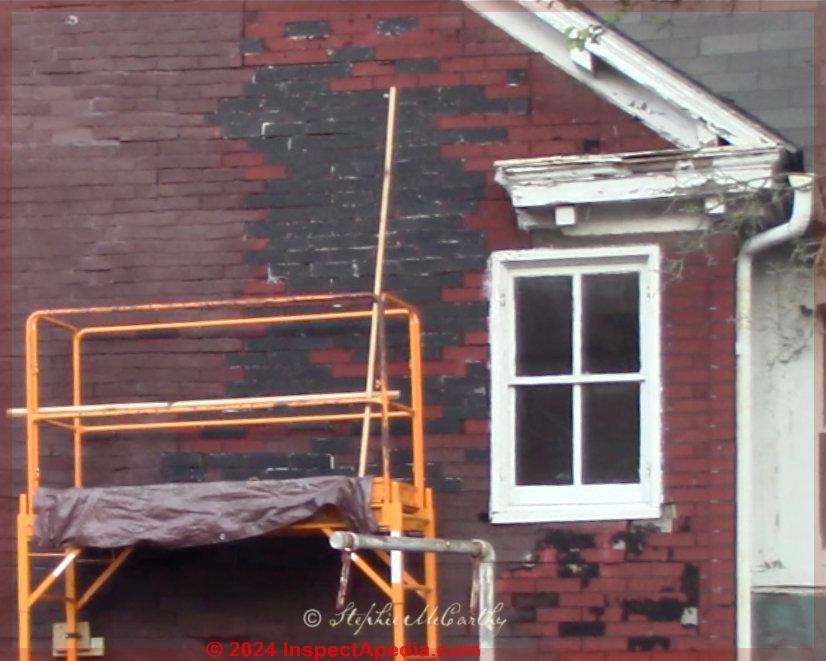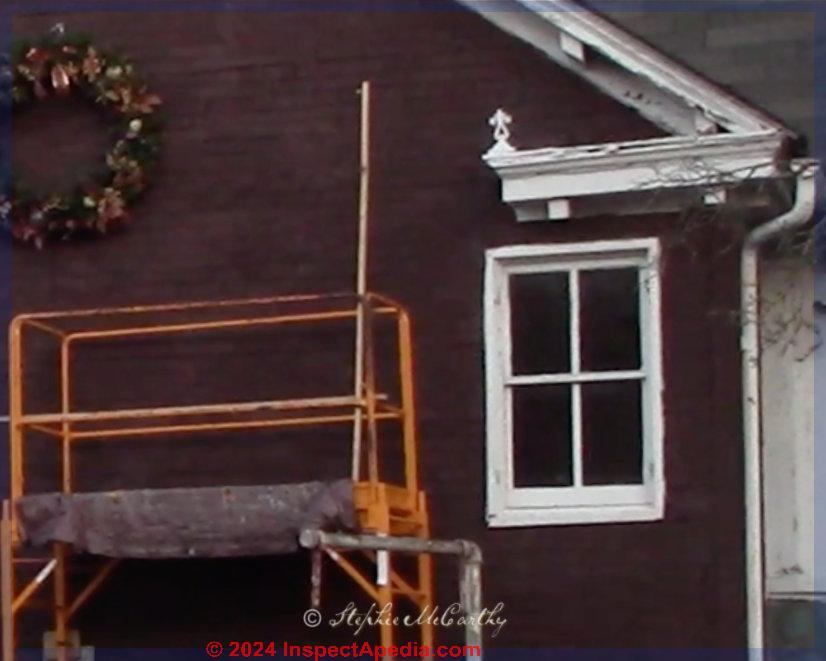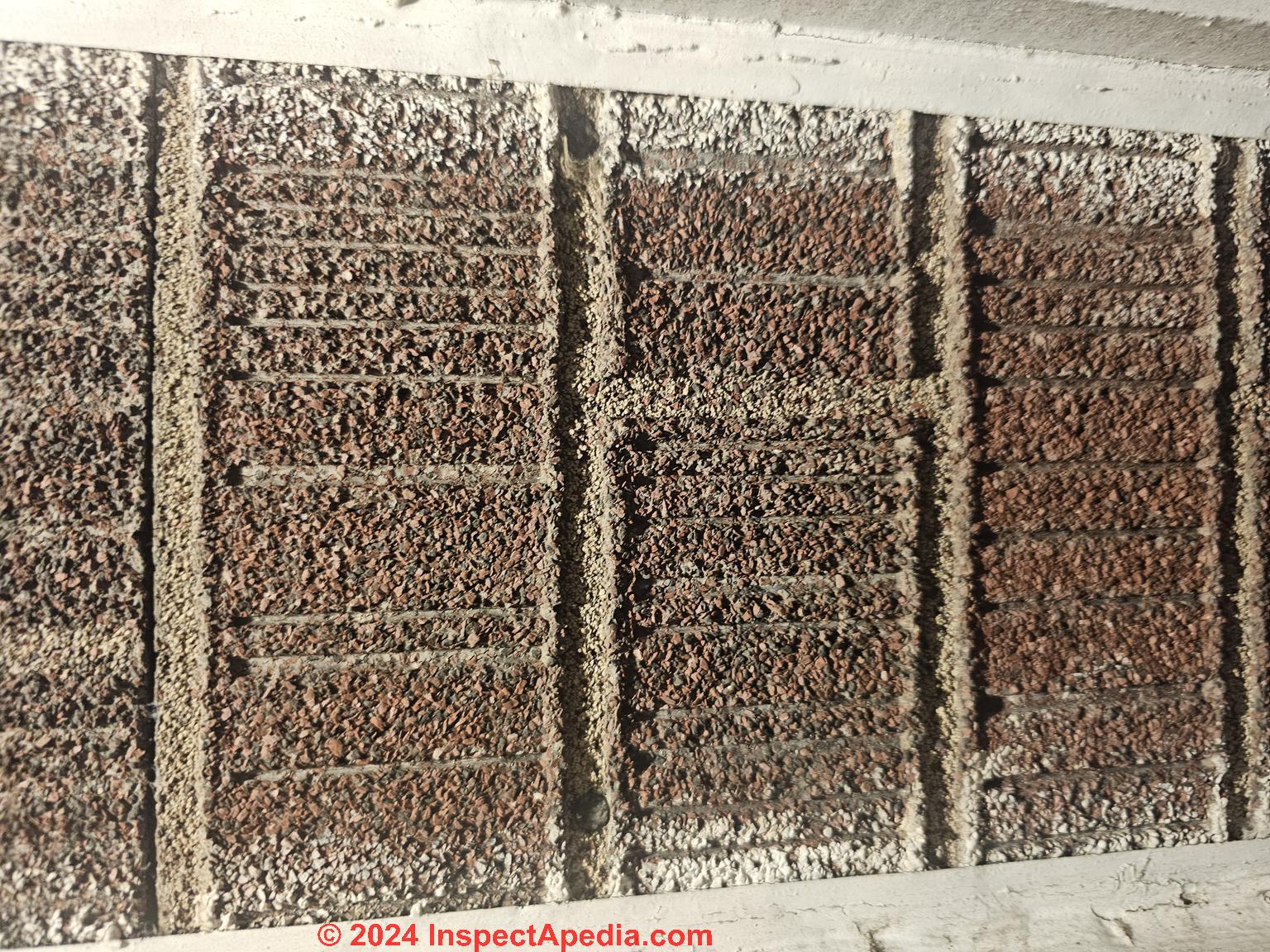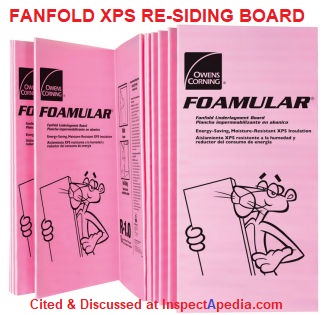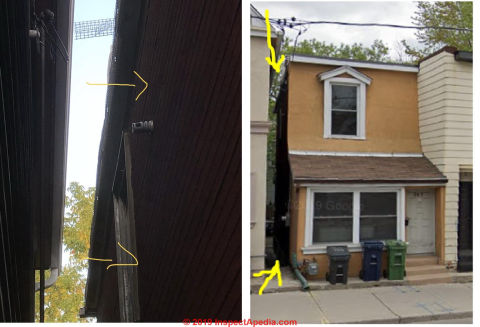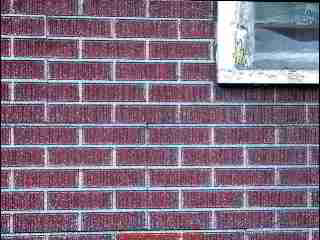 Asphalt Siding FAQs
Asphalt Siding FAQs
Q&A about asphalt shingle siding
- POST a QUESTION or COMMENT about asphalt-based building siding products
Asphalt building siding questions & answers:
Questions and answers about asphalt-based exterior siding in brick, stone & other patterns, including product names, history, availability, repair, and inspection.
This article series provides history and photographs of asphalt-based siding products and discusses common defects observed in asphalt exterior building siding.
InspectAPedia tolerates no conflicts of interest. We have no relationship with advertisers, products, or services discussed at this website.
- Daniel Friedman, Publisher/Editor/Author - See WHO ARE WE?
Asphalt Siding Questions & Answers
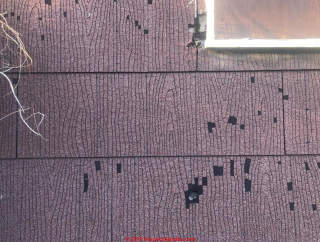 Questions & answers about asphalt siding products on buildings that were posted originally
Questions & answers about asphalt siding products on buildings that were posted originally
at SIDING ASPHALT SHINGLE or SHEET - be sure to see the identification, history, installation and other advice given there.
There we note that:
Asphalt building siding became a popular building renovation alternative to painting weathered or rotted wood clapboard or wood shingle siding as early as the 1930's, becoming popular in the 1940's and the 1950's in North America where it was used both for low-cost housing and for covering the deteriorated exterior walls of older homes.
DIY Insulbrick patch and repair job
We were able to fix our Inselbric siding to look great again. We removed loose material, sprayed with flat primer, glued on hand-cut asphalt bricks where missing, and then finished with Behr Multi-Surface Roof Paint. Check out the pictures in this HomeTalk article. https://www.hometalk.com/posts/can-i-paint-my-roof-yes-we-found-the-paint-45142186
If anyone needs more information about restoring Inselbric, you can leave a comment on my HomeTalk article and I will see it. 2025-03-27 by Stephanie McCarthy
Patch stage
Finished restoration
Reply:
@Stephanie McCarthy,
Nice idea, Stephanie; certainly an unusual one, perhaps a step towards an historic preservation.
You might want to see the preservation references at
SIDING ASPHALT SHINGLE or SHEET - topic home (you're on the FAQs page)
at
https://inspectapedia.com/exterior/Asphalt_Siding_Guide.php
Daniel
Asphalt based brick pattern siding
I cannot identify this siding on my house. The original house was built in 1900. The whole house has the siding but an addition was built 1920s to 1930s. 2024-09-17 by Nicole
Reply:
@Nicole,
I would need to see some more photos, giving me more detail, perhaps, though you're close up is very good, a more distant view would tell me what I'm looking at.
I suspect it is asphalt based brick pattern siding, possibly mounted on hardboard.
Take a look at our page for this topic
https://inspectapedia.com/exterior/Asphalt_Siding_Guide.php
SIDING ASPHALT SHINGLE or SHEET
Fanfold and housewrap before new vinyl siding?
I'm I'm installing new vinyl siding next week. The work order calls for fanfold and housewrap. The existing siding is asphalt siding. What do u think the process is? Is it possible to put 1 or the other or both? 2022-09-10 by Monica Hernandez
Reply:
@Monica Hernandez,
It's possible to install vinyl siding over other building siding materials, though the builder MIGHT need to install supporting furring strips depending on the type & condition of the building sheathing under the old asphalt shingle siding.
I'm unclear what is meant by your question about "the process" -
I'm unclear what is meant by your question 1 or the other or both - both what?
For other readers, "fanfold" in Monica's comment refers to a foam re-siding board made of expanded polystyrene or "XPS" such as that sold by Owens Corning and illustrated below. It's a thin insulating board (R-value = R-1) that helps level or smooth the surface over which new siding is being installed.
The implication of a building re-siding bid that specifies using fanfold foam residing board is that the builder is siding OVER the existing siding.
In many cases that added thickness brings the siding out even with or even past the trim surrounding windows, doors, corners: in that case, for aesthetic reasons some owners want the trim built out to project past the new siding's finished surface so that the building's windows and doors don't take on a sunken eyes look for those openings.
Here's a OWENS CORNING XPS FANFOLD RESIDING BOARD DATA SHEETE [PDF]
https://inspectapedia.com/exterior/Fanfold-Foam-Residing-Board-Data-Sheet-OC.pdf
Excerpt: FANFOLD foam residing board is a thin perforated, extruded polystyrene foam board faced on one side with a plastic film facer and combines proven XPS foam technology with a unique design to enhance the application of new or replacement siding.
Red asphalt siding available anywhere?
is asphalt siding available anywhere? red 2022-01-18 by chris
Reply:
@chris,
Faux-brick or faux-stone asphalt siding such as the brand Inselbric is no longer produced, nor would I recommend it for use on buildings.
Approaches to cover asphalt siding with vinyl siding
Can you cover this stuff with Vinyl siding? Buying a house that was built in 1964, which is covered in Asphalt siding. It looks just like brick...from a distance. 2021-02-08 by Suzy
Reply:
Yes there are at least two approaches to cover asphalt siding with vinyl siding:
Nail directly over
Nail onto furring strips
“Brick” asphalt shingle on the side of the old garage
I have this “brick” asphalt shingle on the side of the old garage on my property and want to remove it. Trying to figure out if it potentially might have asbestos. 2020-05-23 by Erin
Reply:
It may, including the asphalt backer.
You might want to have a sample tested
Some asphalt-impregnated (paper-based) siding materials contain asbestos
 Just wondering if this siding may have asbestos. The home was built in 1940 in IL 2020-02-19 by Marina
Just wondering if this siding may have asbestos. The home was built in 1940 in IL 2020-02-19 by Marina
Reply:
Yes, Marina, that's an asphalt-based shingle siding. Some asphalt-impregnated (paper-based) siding materials contain asbestos.
Asphalt asbestos shingle siding on old garden shed
I pushed down this old garden shed on some farm property I bought and then had the afterthought that the shingle type stuff the old fellow had used might contain asbestos.
I’m attaching a photo.
This stuff is in large sheets and made to look like a brick pattern. 2020-01-20 by Jenna Cossey
Reply:
Jenna
It is indeed possible that the asphalt-impregnated felt backer supporting that siding contained asbestos. You'll minimize the potential dust hazard by avoiding grinding, sawing, chopping the material.
Depending on where you live (country, city, county or province) you may be able to dispose of all of that building as construction debris.
Installing aluminum siding over insulbrick?
Are there any risks to installing aluminum siding over insulbrick? I have insulbrick along one wall of a semi-detached house. It is deteriorating n minor ways (nails coming out, cracking), and that side of the house house is pretty leaky based on a recent air-leakage test.
I've had few contractors quote on removing the insulbrick, installing tyvek and 1 inch insulation, then aluminum siding.
All but 1 of the contractors suggested I skip the tyvek and just go right over top of the insulbrick with 3/4" insulation that is well taped, then aluminum siding over that. Are there any risks to this approach? 2019-10-15 by Brook
Mod reply:
In the second approach you will find that the windows and doors visually recede into the structure.
Perhaps more so because they may need to add furring strips over the existing siding on to which the aluminum siding will be nailed.
What people do is build out the trim around those openings. If you do that it will add some cost to the job. It's also the case that having siding without a house wrap is not going to reduce the air leakage of the building.Reader follow up: skip the house wrap?
Thanks, for this. A couple of the contractors did talk about capping the windows, but I'll reach out to them with this concern to make sure.
Two of the contractors suggested I could skip the house wrap because the 1" or 3/4" insulation they plan to use (it has foil on both sides?) would have the same effect if taped well. Does this make sense? If it matters, the home is a semi-detached, and I'm really only able to wrap two of the four walls.
Reply: cutting air leakage at insulating board sheathing - housewrap
Some insulating boards taped at seams will cut air leakage; I'd be a little concerned about making a moisture-trap wall if the insulating boards are not going to permit the passage of moisture out of the wall cavities. The purpose of housewrap is to
- prevent actual water penetration into the wall (taped insulating boards can do this )
- serve as a wind and air barrier (ditto)
- serve as a moisture permeable wrap that avoids trapping moisture in the wall cavities (non-breathing exterior wraps taped over the wall don't do this)
The city and country, age of home, type of construction and thus climate and existing wall construction are pertinent.
Follow up:
Because the work is only on one wall of a semi-detached unit, I'm hoping moisture won't be a big issue..
My attached neighbour's place is poorly insulated, so that may factor in. Climate is Toronto, so not too wet, but pretty variant. The wettest times are when we'd have windows open (late spring/summer). Note that the upper window in picture on the left is being removed.
Because the work is only on one wall of a semi-detached unit, I'm hoping moisture won't be a big issue. As you can see, the area is pretty narrow, so I'm not particularly concerned about aesthetics.
My attached neighbour's place is poorly insulated, so that may factor in. Climate is Toronto, so not too wet, but pretty variant. My conjoined neighbour's place leaks like a sieve, and he is fine with that as-is (likely due to cost and he is an elderly pensioner). That said, if new owners came, the chances of them doing a significant reno are almost 100%, so I should look to the future a bit.
The wettest times are when we'd have windows open (late spring/summer). Note that the upper window in picture on the left is being removed.
Reply: asbestos in asphalt shingle siding in Toronto
What you want to do depends in part on your budget and on the proposed costs.
You could just staple up housewrap and hang siding on the existing building IF the clapboards or whatever's there (hard to see) will take nails securely; Then you'd focus on insulating the wall cavity from the inside (if it's not already insulated) perhaps blowing in insulation;
Focus on finding and fixing the main air leaks such as around windows and doors;
If you want an independent expert to survey the home to help you set the repair priorities for the home, are some excellent home inspectors right in Toronto including my friends at Carson Dunlop Associates and my friend Terry Carson (no relation to Carson Dunlop); find them at
HOME INSPECTORS-CANADA
Old gray and insulbrick siding
I have a home with old gray and incilbrick siding all of it is still good and intact except one small just above the front porch roof. the question is how can we put up a section of regular vinyl siding on the front above the porch and be able to properly finish off the corners.
Any help or suggestions will be greatly appreciated. 2019-09-25 by Rob
Reply:
If you're not going to remove the insul brick you will need to install furring strips to carry the siding. Unfortunately that probably means you're going to need to build out the trim around your windows and doors.
How to remove spray paint graffiti from siding
My siding seems to be the same as the picture in Two Harbors, MN, found at the top of the article SIDING ASPHALT SHINGLE or SHEET.
#1 do you know if this is apt to have asbestos? House built in 1901 ish.
#2 can you tell me how to remove spray paint graffiti? Unfortunately there was a fire there & children thought it Fun to do. I'm very upset; Goof-off products didn't work. 2018-10-23 by Karen K.
Reply:
Karen
Some asphalt siding may contain asbestos in the asphalt-impregnated felt backer or asbestos may also be in the asphalt-impregnated paper ("tar paper" or "felt") used as a house-wrap under the siding.
It is very difficult to remove spray paint graffiti without also dissolving or discoloring some of the siding surface coating material itself.
I find that Goof Off works well on some spills and paints but when that does not work for you, you might try:
Motsenbocker's Lift Off 411-01 Spray Paint Graffiti Remover
Blue Sprayable Gel Graffiti Remover - Brick & concrete use - from SoSafe
Try these first on the least obtrusive area, low on the wall. Let me know how those work for you.
What are the common names for brick pattern asphalt siding?
What was the one that was supposed to look like brick called? 2017-10-08 by Anonymous
Mod reply:
Thanks for an excellent question, Anonymous.
In the U.S. as early as 1918 "Faux Brick asphalt-based siding" was discussed in industry publications and by 1930 brick-pattern asphalt siding was sold under a variety of product names depending on its manufacturer.
The following excerpt is quoted from "Asphalt Roofing Materials" published by the Arkansas Historic Preservation Program, retrieved 2017/10/08 original source: paragoninspects.com/articles/pdfs/exterior/ cladding/siding/asphalt/ asphalt-siding-materials-ahpp.pdf
The writers make a useful point, that sometimes asphalt roofing products were being nailed onto building exteriors, perhaps more often on farm outbuildings, as a low-cost siding covering: a feat that probably gave manufacturers the very idea of producing asphalt-based siding in brick and stone patterns.
I have seen faux brick and faux stone asphalt siding that resembled roof shingle materials (flexible asphalt impregnated felt material) and in other forms as asphalt impregnated felt bonded to a hardboard backer to form more-rigid siding materials.
The most-generic name for this product would be faux-brick asphalt siding.
Quoting: (I have deleted the article's footnote reference numbers since all of those are dead links)
Faux brick was the prevailing asphalt siding style during the 1930s. Mastic Corporation reported that 100% of its sales in 1935 were in the brick design marketed as panels called Inselbric, but wall shingles were still marketed in a variety of patterns and colors such as rectangular, hexagonal and pyramidal in green, tan and blended.
In 1940 Sears, Roebuck & Company catalogues offered brick-type insulating panels in 14" X 43" units, five bricks high and four-point (hexagonal) asphalt siding in brown tone, red tone, jade green and tile red. Advances in the production of roll roofing introduced heated rollers that pressed detailed patterns into granulated surfaces, making it possible to offer rolled asphalt brick siding in the early 1940s.
By 1941 Sears invited customers to "make old houses look new" by applying Honor Bilt Brick Roll-Type siding in 32" X 43’ sections, which was offered in addition to the four brick double lap siding - marketed by the company beginning circa 1937.To lend a finished look to the job accessory strips for inside and outside corners, edge trim and soldier courses were available. By 1943 they included 32" X 43’ asphalt rolls of irregularly coursed "ashlar stone" (also known as Inselstone) in gray.
The 1954 Sears catalogue introduced a new insulating stone design called "Ranch Stone", featuring elongated multi-colored asphalt units resembling cut-sandstone in irregular courses on 15" X 48" panels. Color selections were gray/green and crab orchard.
In 1966 the Sears, Roebuck catalogue featured "Random Stone" as a new siding product. This was very similar to Ranch Stone but it included randomly placed raked shapes in imitation of wire-cut bricks among the multi-colored units.Random Stone consisted of wood fiber insulation board impregnated with bitumen and thickly overlaid with mineral-stabilized asphalt on the weather side and surfaced with mineral granules for color. Color ranges became rather elaborate in comparison to earlier asphalt siding choices.
The color selections were referred to as "Holiday," which was brown and light gray with coral highlights and beige mortar, "Riviera," consisting of shades of gray with occasional coral and gray mortar and "Lakeside," displaying green overtones with harmonizing gray and beige mortar.
- Arkansas Historic Preservation Program, 1100 North Street, Little Rock, AR 72201 USA, Tel: 501-324-9880 Email: info@arkansaspreservation.orgFollow up:
think it was called bricktex.
Reply:
Kevin
Yes there were a number of faux-brick siding products sold over many years, some using an asphalt based backer, others hardboard backer and still others cementious products.
These include products like those in this article series, often in 18x28" rectangular panels nailed to the building wall:
BrickTex or Brick-Tex, faux brick sidingInsul-Brick (rudely nicknamed "Ghetto Brick")
PermaStone - see PERMA-STONE EXTERIORS
Of interest are these patents helping trace the history of Brick-Tex like products
- Chezem, Samuel S. "Device for marking artificial stone." U.S. Patent 833,675, issued October 16, 1906.
- Hillebrand, William. "Machine and method for making dry-pressed rough-texture brick." U.S. Patent 1,517,452, issued December 2, 1924.
- Shope, David F., "Process for making corrugated-faced cement brick." U.S. Patent 1,591,406, issued July 6, 1926.
- Birdsall, Albert H. "Process of making a composition sheet or slab." U.S. Patent 1,815,608, issued July 21, 1931.
- Polak, Louis. "Finish for walls." U.S. Patent 2,162,861, issued June 20, 1939. Excerpt: This is for the purpose of imitating brickwork, tiles ...
- John, Herck. "Method for producing designs on building walls." U.S. Patent 2,595,142, issued April 29, 1952.
- Schiffer, Henry. "Simulated brick or tile." U.S. Patent 4,349,588, issued September 14, 1982.
Comparative costs of different siding materials
Me too on looking for a supplier of asphalt-based faux-brick. I have an old shed and it seems like a waste of money to use any of the modern alternatives. 2017-08-03 by Tom
Reply:
I think I'd look at these options, noting that prices vary depending on where you live, complexity, windows, doors, local taxes &c.
Typical U.S. Prices for Siding per 100 sq.ft. - Material Costs for DIY projects
- Vinyl siding: $80 - $100 but note that a layer of plywood or OSB heathing is needed below
- Wood Cedar 4x8 sheets: $100 - $125 LP "SmartSide"
- Plywood siding, T111-LIKE: $100 - $200 "Plytanium" exterior grade plywood
- Plywood veneer on hardboard: $120 - $200 "Duratemp"
- Fiber cement shingle: $300. GAF Weatherside
- Aluminum siding: $200 / square (Menard's 8" Textured Solid Color prices in October 2017)
- Fiber cement shingles: $100 - $120 (GAF Weatherside at Home Depot)
- Nailon Brick Siding Panels: $500 / square
- Thinbrick Siding: $380 - $680 / square (redlandbrick.com 2017)
- Brickface: $ see nailon, zbrick type siding and thinbrick siding above
Some Installed Prices for Exterior Wall Coverings
- Stucco, synethetic: $600 - $1000 - INSTALLED
- Fiber cement siding $600 - $1000 - INSTALLED
- Stone Facing: $1200 - $2200 - INSTALLED
Red brick asphalt siding replacement?
Hi, My employer is looking for some of the red brick asphalt siding. I saw in your article that you asked readers to share if they found any available. I was wondering if they did find any.
Reply:
No TH I don't think you'll find anyone selling a match for asphalt-based "faux" brick siding nor for masonite or hardboard based faux-brick siding for buildings.
One company, Creative Faux Panels, fauxpanels.com, advises that you remove all of the existing asphalt or hardboard based faux brick siding and install their bug and weather resistant polyurethane panels.This can work but their answer will not help someone who just wants to repair an area of limited damage to the original asphalt or hardboard siding on an older home.
A full tear-off and replace job is so expensive that once you reach that point you will want to consider all of the various re-siding options: wood, vinyl, alumium, fiberboard, cement board, polyurethane (that may have its own moisture trap concerns on buildings) siding, etc.
My suggestion for a limited faux-brick asphalt based siding repair on a building is to either
1. re-side the area completely using a new and different material without trying to match the original brick, perhaps choosing the area of repair and material to blend in aesthetically, such as forming an accent panel
2. remove intact asphalt-based red-brick siding panels from another, less visible building area, use them to repair the visible area of damage, then re-side the less-visible area in new material.
Book on building materials and material off-gasing of irritant/toxic gases
I would like to compliment you on your website. It is chock full of very helpful, interesting information--lots of pics and very well explained.
Am writing a book on building materials and material off-gasing of irritant/toxic gases and have frequently found myself at your website. Just wanted to thank you. (Dec 8, 2014) by Kathleen
Reply:
Thanks Kathleen. We are glad you found our information useful - we work hard to make it accurate and unbiased and researched.
If you are considering asking for contributions to the content of your book, I'll paste in a portion of our content use policy: CONTENT USE POLICY On use of our website content. You'll see that we can often contribute photos or text for use in printed or educational materials.
We would be pleased for you to pass on to others links to articles or to use PRINTED (only) copies of articles or photos quoted from our InspectApedia.com website or if appropriate, to make and give away printed copies of our web page material in a class or professional presentation, printed text, printed article, or printed book, or in a classroom presentation, (such as power point slides that are not elsewhere reproduced electronically), provided you agree to respect these simple provisions [OMITTED HERE]
Also let me know when your book is ready as I'd be glad to review it and inform our readers about it.
Painting asphalt siding
can u use some type of sealer on asphalt siding to make it look newer and better. return to Eagleflying100@aol.com (June 2, 2015) by Anonymous
Reply:
Anon you could use a paint formulated for use on asphalt roofs on asphalt shingle or panel siding as well.
...
Continue reading at SIDING ASPHALT SHINGLE or SHEET or select a topic from the closely-related articles below, or see the complete ARTICLE INDEX.
Or see these
Recommended Articles
- ASBESTOS CEMENT SIDING
- ASPHALT-ASBESTOS FELT
- ASPHALT ROOF MATERIAL ASBESTOS
- SIDING TYPES, INSTALLATION, DEFECTS - home
Suggested citation for this web page
ASPHALT SIDING FAQs at InspectApedia.com - online encyclopedia of building & environmental inspection, testing, diagnosis, repair, & problem prevention advice.
Or see this
INDEX to RELATED ARTICLES: ARTICLE INDEX to BUILDING SIDING
Or use the SEARCH BOX found below to Ask a Question or Search InspectApedia
Ask a Question or Search InspectApedia
Questions and answers about asphalt-based building siding products.
Try the search box just below, or if you prefer, post a question or comment in the Comments box below and we will respond promptly.
Search the InspectApedia website
Note: appearance of your Comment below may be delayed: if your comment contains an image, photograph, web link, or text that looks to the software as if it might be a web link, your posting will appear after it has been approved by a moderator. Apologies for the delay.
Only one image can be added per comment but you can post as many comments, and therefore images, as you like.
You will not receive a notification when a response to your question has been posted.
Please bookmark this page to make it easy for you to check back for our response.
IF above you see "Comment Form is loading comments..." then COMMENT BOX - countable.ca / bawkbox.com IS NOT WORKING.
In any case you are welcome to send an email directly to us at InspectApedia.com at editor@inspectApedia.com
We'll reply to you directly. Please help us help you by noting, in your email, the URL of the InspectApedia page where you wanted to comment.
Citations & References
In addition to any citations in the article above, a full list is available on request.
- In addition to citations & references found in this article, see the research citations given at the end of the related articles found at our suggested
CONTINUE READING or RECOMMENDED ARTICLES.
- Carson, Dunlop & Associates Ltd., 120 Carlton Street Suite 407, Toronto ON M5A 4K2. Tel: (416) 964-9415 1-800-268-7070 Email: info@carsondunlop.com. Alan Carson is a past president of ASHI, the American Society of Home Inspectors.
Thanks to Alan Carson and Bob Dunlop, for permission for InspectAPedia to use text excerpts from The HOME REFERENCE BOOK - the Encyclopedia of Homes and to use illustrations from The ILLUSTRATED HOME .
Carson Dunlop Associates provides extensive home inspection education and report writing material. In gratitude we provide links to tsome Carson Dunlop Associates products and services.


